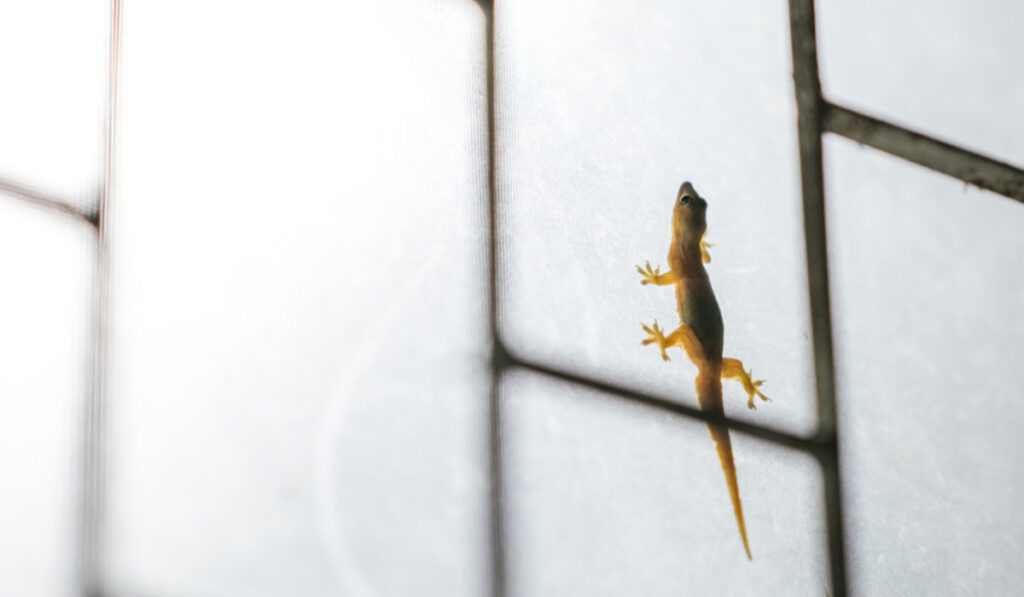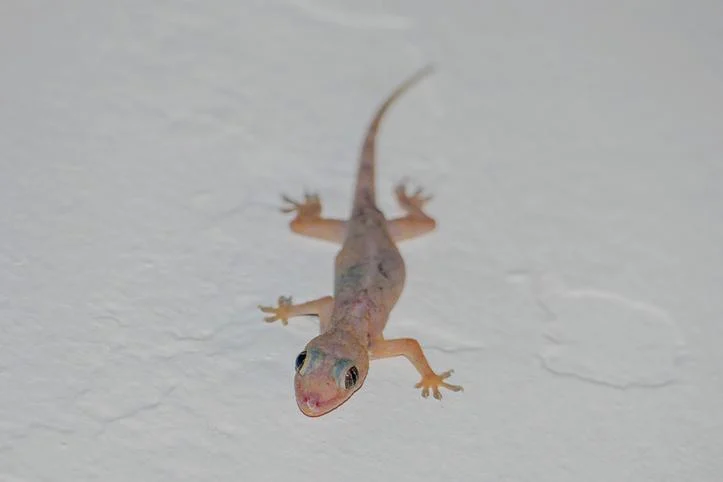Catching a lizard in your house requires a calm and methodical approach to ensure both your safety and the lizard’s. Begin by closing doors and windows to contain the lizard within one room. Locate the lizard’s hiding spot, typically in dark and warm areas like behind furniture or under appliances.
Equip yourself with gloves and a small container or cardboard to safely catch the lizard. Approach the lizard slowly and quietly, guiding it into the container if within reach, or trapping it with the container if on the floor or wall.
Once caught, release the lizard outside in a suitable habitat with vegetation and shelter. Prevent future encounters by sealing entry points and keeping your home clean. If uncomfortable, seek assistance from professional pest control services.
What are indoor lizards’ behavior and habits?

Indoor lizards can encompass a wide variety of species, each with its own specific behaviors and habits. However, here are some general behaviors and habits that are common among many indoor lizard species:
Basking
Like all reptiles, lizards are ectothermic, meaning they rely on external sources of heat to regulate their body temperature. Indoor lizards often bask under heat lamps or UVB lights to thermoregulate.
Hunting and Feeding
Lizards are typically carnivorous or insectivorous, depending on the species. They have keen senses and use them to hunt for prey such as insects, small rodents, or even other lizards.
In captivity, they are usually fed a diet of insects like crickets, mealworms, or dubia roaches, supplemented with occasional treats like pinkie mice or fruits.
Territoriality
Some species of lizards are territorial and may exhibit aggressive behavior towards intruders, including other lizards or even humans. This behavior can be minimized through proper habitat design and socialization.
Hiding and Shelter
Lizards require hiding spots or shelters within their enclosure where they can retreat to feel safe. These hiding spots mimic their natural environment and can include rocks, branches, or artificial hides.
Activity Patterns
Lizards are typically diurnal, meaning they are most active during the day. However, some species may exhibit crepuscular or nocturnal behavior, being more active during dawn or dusk or primarily active at night.
Social Interaction
While many lizards are solitary creatures, some species may tolerate or even benefit from social interaction with other lizards of the same species.
However, care should be taken when housing multiple lizards together to avoid aggression and stress.
Communication
Lizards may use various forms of communication, including visual displays (such as head-bobbing or dewlap extensions), vocalizations, and chemical cues (pheromones) to communicate with each other.
Reproduction
Breeding behavior varies among different lizard species, but generally, males may display courtship rituals to attract females.
After mating, females may lay eggs or give birth to live young, depending on the species.
How To prepare for catching indoor lizards effectively?

Preparing to catch indoor lizards effectively involves understanding their behavior, which includes being most active at night and hiding during the day in dark, secluded areas. Gather necessary supplies, such as a flashlight or headlamp, a small container with a lid, and gloves if needed. Create an enticing environment by leaving lights on near windows to attract insects, which in turn attract lizards.
Patience and observation are key; move quietly and slowly, using the flashlight to scan likely hiding spots. Approach lizards calmly, corner them gently, then trap them under a container and slide a piece of paper underneath. Handle them with care if necessary, and release them safely outside. Repeat the process as needed to catch all the lizards in your home.
What Are Effective Methods For Catching Indoor lizards?

Effective methods for catching indoor lizards involve a combination of understanding their behavior, using the right tools, and employing patience and gentleness. Start by understanding that lizards are often most active at night and tend to hide in dark, secluded areas during the day.
Use a flashlight or headlamp to scan these areas, such as behind furniture or in closets, and be patient in your search. When you spot a lizard, approach it calmly and slowly, then gently corner it and trap it under a container.
Slide a piece of paper or cardboard underneath to capture the lizard without harming it. Handle the lizard with care if necessary and release it safely outside. Repeat the process as needed until you’ve caught all the indoor lizards in your home.
FAQ’s
Do lizards come near humans while sleeping?
Lizards may occasionally venture near sleeping humans if they are seeking warmth or hunting insects attracted to humans.
What are lizards afraid of?
Lizards are generally afraid of sudden movements, loud noises, and potential predators, but they may also exhibit caution around unfamiliar objects or environments.
Will a lizard crawl on my bed?
While it’s not common, lizards might crawl onto a bed if they are exploring or searching for warmth. Keeping your bedroom tidy and sealing off entry points can reduce the likelihood of this happening.
Is a lizard in the room good or bad?
Having a lizard in the room can be beneficial as they help control insect populations. However, some people may find them undesirable due to fear or hygiene concerns.
Do lizards like darkness or light?
Lizards typically prefer dark or dimly lit environments during the day to avoid predators and regulate their body temperature. However, they may become more active in well-lit areas during the night when hunting for food.
Final Words
Catching lizards in the house requires patience and preparation. Understanding the behavior of indoor lizards helps in devising effective strategies. By preparing adequately and using the right techniques, such as manual capture or luring the lizard out with bait, one can safely catch a lizard.
After catching a lizard, it’s important to handle it safely and release it back into its natural habitat. Disinfecting the area and taking preventive measures can help avoid future infestations. Overall, taking humane and responsible approaches ensures a successful outcome in dealing with indoor lizards.
